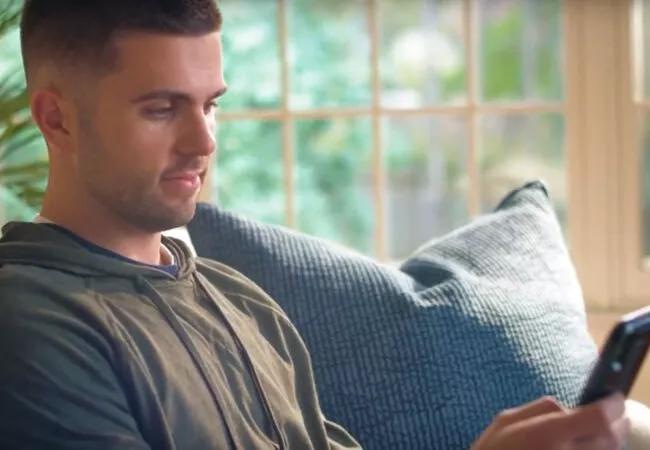Advertisement
Patient and physician friendly format is here to stay

If there’s a silver lining to the COVID-19 pandemic, it’s the accelerated acceptance of virtual visits.
Advertisement
Cleveland Clinic is a non-profit academic medical center. Advertising on our site helps support our mission. We do not endorse non-Cleveland Clinic products or services. Policy
Cleveland Clinic’s Department of Gastroenterology, Hepatology & Nutrition has experienced the advantages to conducting outpatient visits via telemedicine and embraced it fully. The department expects to conduct 100% of all new and established patient visits digitally in the next couple of months. This is well ahead of the previous goal of 2024.
“About 80% of our physicians now conduct virtual visits — up from 30% to 35% prior to the COVID-19 pandemic,” says Miguel Regueiro, MD, Chair of the Department. “We are pushing for 100% of our staff to be virtual visit-capable by April 30.”
Patients love virtual visits, says Dr. Regueiro. Overall, they appreciate the simplicity of seeing a doctor at their convenience without the hassle of driving, parking and negotiating a large medical center.
Those with conditions treated in population health models such as the IBD medical home find virtual visits save time.
“When these patients would come to the clinic, they would have appointments with their gastroenterologist, psychologist, nurse practitioner, dietitian and surgeon. It was a long day,” says Dr. Regueiro, who pioneered the medical home concept at Cleveland Clinic. “With virtual visits, they have the option of seeing their IBD team members sequentially or at different times.”
Breaking one long visit into smaller, more manageable doses enables them to digest large amounts of information more easily.
“Some patients have told me they like to have a break between appointments to look up information on the internet or think about what they were told. It feels less overwhelming. My hope is that they are able to retain more of what we tell them,” he says.
Although the computer seems like an unlikely vehicle for conducting an intimate conversation, the camera can be positioned to allow the physician and patient to maintain eye contact — something patients notice and appreciate.
“Many of us have two computer screens side by side, one for our electronic medical records system, and one with a camera on the patient. This means we don’t have to turn away from the patient to take notes, like we do in the clinic,” says Dr. Regueiro.
Although some physicians are reluctant to give up their tried-and-true way of practicing medicine, Dr. Regueiro has found that even the most vehemently opposed eventually admit to finding virtual visits enjoyable.
“It is a very different approach to patient care, yet patients are so appreciative, that it reflects positively on their physician,” he says.
Personally, he has found virtual visits tend to be more concise than in-person visits, but equally productive. As a result, he is able to stay on schedule — an impossible task during a normal clinic day.
Advertisement
“I find that 18 to 22 minutes into a 30-minute visit, I am wrapping up, have answered their questions, and have time to finish clinical notes before starting the next patient,” he says. “I think physician burnout could be a lot less with virtual visits.”
He admits there are some drawbacks: You can’t palpate a patient or do a physical exam. Yet today’s technology still makes it possible to successfully conduct many intimate aspects of an exam.
“If you need to see a stoma, fistula or rash, some patients will take the camera and show you. With the high resolution images provided by today’s cameras, it’s like you are there,” he says.
Dr. Regueiro is such an advocate of virtual visits that he is urging gastroenterologists around the country and throughout the world to follow Cleveland Clinic’s lead.
“I think virtual visits will be the new ‘coin of the realm’ in healthcare,” he says. “My staff is tired of hearing me say that, but I believe it’s true. When this crisis passes, I expect we will continue to conduct 50% of our appointments virtually.”
Nationwide, he says too many other GI centers — primarily smaller practices — have been slow to embrace telehealth technology. This worries him, since it’s not a question of wanting to change; it’s a question of having to change.
“Unfortunately, groups that are not adopting telehealth are being left behind. Due to the COVID-19 pandemic, some hospitals and smaller practices have started to lay off healthcare workers, leaving patients to look for alternatives,” he says.
The COVID-19 crisis spurred the government into moving with uncharacteristic speed to cover telehealth visits by physicians, dietitians and psychologists. Other payors followed suit, and the rush to move toward virtual visits accelerated.
For patients who can’t figure out the technology and have no family members who can help them, virtual visits conducted over FaceTime or on the phone are also covered. “I have a sense these options may go away after the crisis ends, but for now, they are an excellent plan B,” says Dr. Regueiro.
Even if reimbursement for FaceTime and phone calls eventually stops, Dr. Regueiro expects physicians will continue to live in the digital world for a long time.
“Physicians and patients love it. If you haven’t embraced telehealth, you need to get on board,” he says.
Advertisement
Advertisement

Patients report improved sense of smell and taste

Clinicians who are accustomed to uncertainty can do well by patients

Unique skin changes can occur after infection or vaccine

Cleveland Clinic analysis suggests that obtaining care for the virus might reveal a previously undiagnosed condition

As the pandemic evolves, rheumatologists must continue to be mindful of most vulnerable patients

Early results suggest positive outcomes from COVID-19 PrEP treatment

Could the virus have caused the condition or triggered previously undiagnosed disease?

Five categories of cutaneous abnormalities are associated with COVID-19